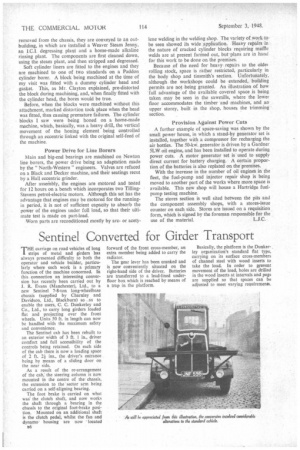Sentinel Converted for Girder Transport
Page 40

If you've noticed an error in this article please click here to report it so we can fix it.
THE carriage on road vehicles of long strips of metal and girders has always presented difficulty to both the operator and vehicle builder, particularly where such work is a primary function of the machine concerned. In this connection an interesting conversion has recently been carried out by J. R. Evans (Manchester), Ltd., to a new Sentinel 7-8-ton long-wheelbase chassis (supplied by Charnley and Davidson. Ltd., Blackburn) so as to enable the users, C. C. Dunkerley and Co., Ltd., to carry long girders loaded flat and projecting over the front wheels. Units 50 ft. in length can now be handled with the maximum safety and convenience.
The Sentinel cab has been rebuilt to an exterior width of 3 ft. I in., driver comfort and full accessibility of the controls being retained. On each side of the cab there is now a loading space of 2 ft. 21 ins., the driver's entrance being by means of a sliding door on the near side.
As a result of the re-arrangement of the cab; the steering column is now mounted in the centre of the chassis. the extension to the sector arm being carried on a self-aligning bearing.
The foot brake is carried on what was the clutch shaft, and now works the shaft through a bearing in the chassis to the original foot-brake position. Mounted on an additional shaft is the clutch pedal, whilst the fan and dynamo housing are now located 56 forward of the front cross-member, an extra member being added to carry the radiator.
The gear lever has been cranked and is now conveniently situated on the right-hand side of the driver. Batteries are transferred to a lead-lined underfloor box which is reached by means of a trap in the platform.
Basically, the platform is the Dunker-. ley organization's standard flat type, carrying on its surface cross-members of channel steel with wood inserts to take the load. In order to prevent movement of the load, holes are drilled in the wood inserts at intervals and pegs are supplied so that spaces can be adjusted to meet varying requirements.




















































































